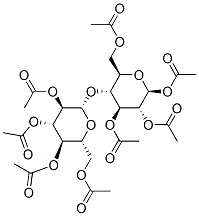-
Name
alpha-D-Cellobiose octaacetate
- EINECS 226-304-5
- CAS No. 5346-90-7
- Density 1.37 g/cm3
- Solubility chloroform: 0.1 g/mL, clear, colorless to faintly brownish-yellow
- Melting Point 225-232 °C
- Formula C28H38O19
- Boiling Point 683.055 °C at 760 mmHg
- Molecular Weight 678.598
- Flash Point 281.178 °C
- Transport Information
- Appearance white powder
- Safety 24/25-36-26
- Risk Codes 20/21/22-36/37/38
-
Molecular Structure
-
Hazard Symbols
 Xn
Xn
- Synonyms Cellobiose,octaacetate, a-D-(8CI);a-D-Glucopyranose, 4-O-(2,3,4,6-tetra-O-acetyl-b-D-glucopyranosyl)-, tetraacetate(9CI);NSC 1221;NSC 1696;Octa-O-acetyl-a-D-cellobiose;Octaacetyl-a-cellobiose;a-Cellobiopyranose octaacetate;a-Cellobiose octaacetate;a-D-Cellobiose octaacetate;
- PSA 238.09000
- LogP -0.83080
Synthetic route

| Conditions | Yield |
|---|---|
| With perchloric acid at 0 - 20℃; | 95% |
| iron(III) chloride at 28 - 32℃; for 0.5h; | 78% |
| With iodine In dichloromethane at 20℃; for 1h; |
-
-
133-99-3, 490-37-9, 2152-98-9, 4482-75-1, 5965-66-2, 13299-27-9, 13360-52-6, 14641-93-1, 15548-43-3, 16462-44-5, 16984-36-4, 16984-38-6, 20869-27-6, 22688-72-8, 27452-49-9, 29276-55-9, 30608-12-9, 34481-13-5, 37169-60-1, 37169-64-5, 64234-01-1, 64234-02-2, 75281-88-8, 80446-85-1, 84413-57-0, 92344-56-4, 93221-87-5, 93301-77-0, 94799-29-8, 100427-98-3, 100428-00-0, 101312-82-7, 102046-24-2, 102046-25-3, 109432-00-0, 109432-02-2, 109432-04-4, 109432-08-8, 135268-49-4, 138231-26-2, 140461-59-2, 145414-22-8, 145414-26-2, 146339-75-5, 146339-76-6, 149116-55-2, 528-50-7
Cellobiose

-
-
108-24-7
acetic anhydride

-
A
-
20764-63-0
β-cellobioseoctaacetate

-
B
-
5346-90-7
α-D-cellobiose octaacetate

| Conditions | Yield |
|---|---|
| With pyridine at 20℃; diastereoselective reaction; | A n/a B 95% |
| With H-Beta zeolite for 48h; Ambient temperature; Yield given. Yields of byproduct given. Title compound not separated from byproducts; | |
| Stage #1: Cellobiose With ammonium chloride; ammonia In methanol at 0℃; for 0.5h; Stage #2: acetic anhydride In pyridine at 20℃; for 12h; Title compound not separated from byproducts; |

-
-
133-99-3, 490-37-9, 2152-98-9, 4482-75-1, 5965-66-2, 13299-27-9, 13360-52-6, 14641-93-1, 15548-43-3, 16462-44-5, 16984-36-4, 16984-38-6, 20869-27-6, 22688-72-8, 27452-49-9, 29276-55-9, 30608-12-9, 34481-13-5, 37169-60-1, 37169-64-5, 64234-01-1, 64234-02-2, 75281-88-8, 80446-85-1, 84413-57-0, 92344-56-4, 93221-87-5, 93301-77-0, 94799-29-8, 100427-98-3, 100428-00-0, 101312-82-7, 102046-24-2, 102046-25-3, 109432-00-0, 109432-02-2, 109432-04-4, 109432-08-8, 135268-49-4, 138231-26-2, 140461-59-2, 145414-22-8, 145414-26-2, 146339-75-5, 146339-76-6, 149116-55-2
α-cellobiose

-
-
108-24-7
acetic anhydride

-
-
5346-90-7
α-D-cellobiose octaacetate

| Conditions | Yield |
|---|---|
| With vanadyl triflate at 20℃; for 60h; | 85% |
| With pyridine at 100℃; for 3h; Acetylation; |
-
-
66073-13-0, 71623-44-4, 101981-29-7, 109922-72-7, 109922-73-8, 132287-75-3, 132287-76-4, 132287-78-6, 132303-63-0, 134311-82-3, 134333-39-4, 18464-08-9
α-D-glucopyranose-4-O-(2,3,4,6-tetra-O-acetyl-β-D-glucopyranosyl)-2,3,6-triacetate

-
-
108-24-7
acetic anhydride

-
-
5346-90-7
α-D-cellobiose octaacetate

| Conditions | Yield |
|---|---|
| In pyridine Ambient temperature; Yield given; |
-
-
71692-91-6
(2R,3R,4S,5R,6S)-2-(acetoxymethyl)-6-(((2R,3R,4S,5R,6S)-4,5-bis(benzyloxy)-2-((benzyloxy)methyl)-6-methoxytetrahydro-2H-pyran-3-yl)oxy)tetrahydro-2H-pyran-3,4,5-triyl triacetate

-
-
108-24-7
acetic anhydride

-
-
5346-90-7
α-D-cellobiose octaacetate

| Conditions | Yield |
|---|---|
| With sulfuric acid; hydrogen; palladium on activated charcoal 1.) acetic acid, RT, 40 psi, 2.) 4 h; Yield given. Multistep reaction; |

| Conditions | Yield |
|---|---|
| With sulfuric acid | |
| With sulfuric acid; acetic acid |

| Conditions | Yield |
|---|---|
| Verschmelzen der 2 Edukte, anschl. mit Acetanhydrid und Natriumacetat; |
-
-
14227-66-8
acetobromocellobiose

-
-
5346-90-7
α-D-cellobiose octaacetate

| Conditions | Yield |
|---|---|
| Multi-step reaction with 2 steps 1: 1.) mercuric cyanide; 2.) sodium acetate / 1.) 1,2-dichloroethane, 4 d, 40 deg C; 2.) reflux, 20 min 2: pyridine / Ambient temperature View Scheme |
-
-
19488-48-3
methyl O-2,3,6-tri-O-benzyl-α-D-glucopyranoside

-
-
5346-90-7
α-D-cellobiose octaacetate

| Conditions | Yield |
|---|---|
| Multi-step reaction with 2 steps 1: 1.) 40percent hydrogen bromide, 2.) silver triflate, molecular sieve 4A / 1.) acetic acid, RT, 2 h, 2.) 1,2-dichloroethane, 0 deg C, 1 h 2: 1.) H2, 2.) 4percent sulfuric acid / 1.) 10percent Pd/C / 1.) acetic acid, RT, 40 psi, 2.) 4 h View Scheme |

| Conditions | Yield |
|---|---|
| Multi-step reaction with 2 steps 1: 1.) 40percent hydrogen bromide, 2.) silver triflate, molecular sieve 4A / 1.) acetic acid, RT, 2 h, 2.) 1,2-dichloroethane, 0 deg C, 1 h 2: 1.) H2, 2.) 4percent sulfuric acid / 1.) 10percent Pd/C / 1.) acetic acid, RT, 40 psi, 2.) 4 h View Scheme |
alpha-D-cellobiose octaacetate Chemical Properties
alpha-D-cellobiose octaacetate(5346-90-7) has a melting point of 225-232 °C.
The chemical synonyms of alpha-D-cellobiose octaacetate(5346-90-7) are CELLOBIOSE OCTAACETATE;D-(+)-CELLOBIOSE OCTAACETATE;D-CELLOBIOSE OCTAACETATE;4-O-BETA-D-GLUCOPYRANOSYL-D-GLUCOSE OCTAACETATE;4-O-(2,3,4,6-TETRA-O-ACETYL-BETA-D-GLUCOPYRANOSYL)-1,2,3,6-TETRA-O-ACETYL-ALPHA-D-GLUCOPYRANOSE;A-D-CELLOBIOSE OCTAACETATE;ALPHA-CELLOBIOSE OCTAACETATE;ALPHA-D-(+)-CELLOBIOSE OCTAACETATE
The molecular structure of alpha-D-cellobiose octaacetate(5346-90-7):

alpha-D-cellobiose octaacetate Toxicity Data With Reference
LD50/LC50: RTECS: Not available.
Carcinogenicity: alpha-D-Cellobiose octaacetate - Not listed as a carcinogen by ACGIH, IARC, NTP, or CA Prop 65.
Other: The toxicological properties have not been fully investigated.
alpha-D-cellobiose octaacetate Safety Profile
Risk Statements 20/21/22-36/37/38
Safety Statements 24/25-36-26
WGK Germany 3
F 10-21
alpha-D-cellobiose octaacetate Specification
Conditions to Avoid: Incompatible materials.
Incompatibilities with Other Materials Strong oxidizing agents.
Hazardous Decomposition Products Carbon monoxide, carbon dioxide.
Hazardous Polymerization May occur.
Related Products
- alpha-D-cellobiose octaacetate
- 5347-08-0
- 5347-19-3
- 53472-18-7
- 5347-23-9
- 53473-28-2
- 53473-36-2
- 534-73-6
- 53475-15-3
- 5347-68-2
- 53477-35-3
Hot Products
About|Contact|Cas|Product Name|Molecular|Country|Encyclopedia
Message|New Cas|MSDS|Service|Advertisement|CAS DataBase|Article Data|Manufacturers | Chemical Catalog
©2008 LookChem.com,License: ICP
NO.:Zhejiang16009103
complaints:service@lookchem.com Desktop View